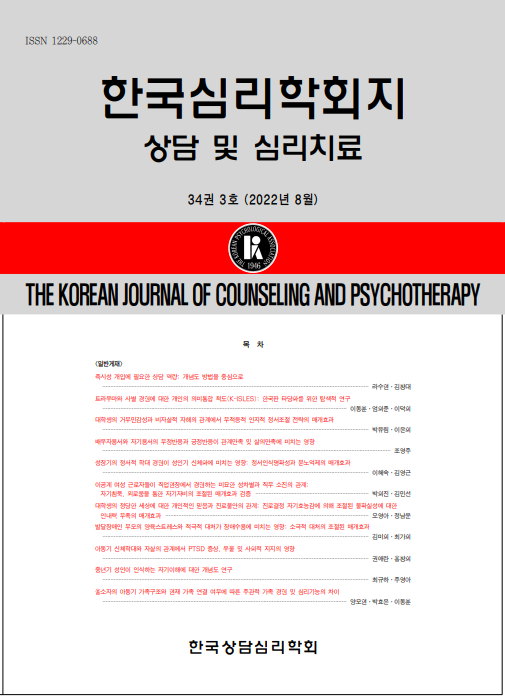open access
메뉴
open access
메뉴 ISSN : 1229-0688
ISSN : 1229-0688
Work valence refers to the degree of attractiveness and aversiveness of working. Work valence is a concept derived from a motivational perspective, which provides a useful framework to understand career-related behaviors. The current study was designed to validate a work valence scale developed by Porfeli and his colleagues (2012) with a sample of Korean adolescents and young adults. We used a sample of 332 college students and 324 high school students to fit two models of work valences. Results revealed that both a two-factor hierarchical model and a one-factor hierarchical model fit well. Moreover, when we tested for invariance between two different age groups, we found that both groups had the same factor structure and factor loadings. Implications for future research are discussed.
김영혜, 안현의 (2012). 사회인지진로이론적 관점에 근거한 국내 진로발달연구의 동향분석: 대학생 연구를 중심으로. 진로교육연구, 25(4), 1-18.
심서영, 하유진 (2012). ‘정서표현 양가성’과 긍정정서, 부정정서, 우울간의 관계: 성격변인의 조절효과. 한국심리학회지: 일반, 31(4), 1073-1092.
오세현, 강현아 (2018). 청소년의 우울이 진로정체감에 미치는 영향: 팬덤 활동의 매개효과를 중심으로. 학교사회복지, 42, 163-185.
이보라, 정지희, 이정림 (2014). 한국어판 진로정체감 지위 측정도구. 상담학 연구, 15(3), 1163-1181.
이순묵, 금은희, 이찬순 (2010). 다집단 분석의 문제: 평균구조분석에서의 측정원점 동일성 검증 필요여부. 교육평가연구, 23(2), 391-416.
이정화 (2018). 진로정체감 형성과정 내 진로탐색의 양상을 예측하는 동기의 기제. 고려대학교 석사학위 논문.
이종찬 (2013). 대학생의 진로결정자기효능감에 관한 이론적 고찰 및 연구성과의 비교분석. 취업진로연구, 3(1), 49-66.
이현희, 김은정, 이민규 (2003). 한국판 정적 정서 및 부적 정서 척도. 한국심리학회지: 임상, 22(4), 935-946.
전겸구, 이민규 (1992). 한국판 CES-D 개발연구 1. 한국심리학회지: 임상, 11(1), 65-76.
조맹제, 김계희 (1993). 주요우울증 예비평가에서 The Center for Epidemiologic Studies Depression Scale(CES-D)의 진단적 타당성 연구. 신경정신의학, 32(3), 381-399.
최윤미, 이문희 (2011). 진로성숙 발달에 영향을 미치는 위험요인과 보호효인. 청소년상담연구, 19(2), 171-187.
탁진국 (2007). 심리검사: 개발과 평가방법의 이해. 서울: 학지사.
Bandura, A. (1965). Vicarious processes: A case of no-trial learning. In Advances in Experimental Social Psychology (Vol. 2, pp. 1-55). New York, NY: Academic Press.
Bandura, A. (1989). Human agency in social cognitive theory. American Psychologist, 44(9), 1175-1184.
Blustein, D. L. (1988). The relationship between motivational processes and career exploration. Journal of Vocational Behavior, 32, 345-357.
Blustein, D. L. (1989). The role of goal instability and career self-efficacy in the career exploration process. Journal of Vocational Behavior, 35(2), 194-203.
Elliot, A. J., & McGregor, H. A. (2001). A 2×2 achievement goal framework. Journal of Personality and Social Psychology, 80(3), 501-519.
Flum, H., & Blustein, D. L. (2000). Reinvigorating the study of vocational exploration: A framework for research. Journal of Vocational Behavior, 56(3), 380-404.
Ford, M. E. (1992). Motivating humans: Goals, emotions, and personal agency beliefs. Newbury Park, CA: Sage Publications.
Goldstein, B., & Oldham, J. (1979). Children and work. New Brunswick, NJ: Transaction Books.
Heckhausen, J., & Tomasik, M. J. (2002). Get an apprenticeship before school is out: How German adolescents adjust vocational aspirations when getting close to a developmental deadline. Journal of Vocational Behavior, 60(2), 199-219.
Hirschi, A., Lee, B., Porfeli, E. J., & Vondracek, F. W. (2013). Proactive motivation and engagement in career behaviors: Investigating direct, mediated, and moderated effects. Journal of Vocational Behavior, 83, 31-40.
Horn, J. L., & McArdle, J. J. (1992). A practical and theoretical guide to measurement invariance in aging research. Experimental Aging Research, 18(3), 117-144.
Lee, B., & Porfeli, E. J. (2015). Youths’ socialization to work and school within the family. International journal for educational and vocational guidance, 15(2), 145-162.
Lee, B., Porfeli, E. J., & Hirschi, A. (2016). Between- and within-person level motivational precursors associated with career exploration. Journal of Vocational Behavior, 92, 125-134.
Lent, R. W., Brown, S. D., & Hackett, G. (2002). Social cognitive career theory. In D. Brown & Associates (Eds.). Career choice and development, 4th edition (pp. 255-311). San Francisco, CA: Jossey-Bass.
Marcia, J. E. (1966). Develompent and validation of ego-identity status. Journal of Personality and Social Psychology, 3(5), 551-558.
Porfeli, E. J., Ferrari, L., & Nota, L. (2012). Work valence as a predictor of academic achievement in the family context. Journal of Career Development, 40(5), 371-389.
Porfeli, E. J., Lee, B., Vondracek, F. W., & Weigold, I. K. (2011). A multi-dimensional measure of vocational identity status. Journal of Adolescence, 34(5), 853-871.
Porfeli, E. J., Lee, B, & Weigold, I. K. (2012). A multidimensional measure of work valences. Journal of Vocational Behavior, 80, 340-350.
Porfeli, E. J., Wang, C, & Hartung, P. J. (2008). Family transmission of work affectivity and experiences to children. Journal of Vocational Behavior, 73, 278-286.
Quigley, N. R., & Tymon Jr, W. G. (2006). Toward an integrated model of intrinsic motivation and career self-management. Career development international, 11(6), 522-543.
Radloff, L. S. (1977). The CES-D Scale: A self-report depression scale for research in the general population. Applied Psychological Measurement, 1(3), 385-401.
Reardon, R. C., Lenz, J., Sampson, J., & Peterson, G. W. (2009). Career development and planning: A comprehensive approach (3rd edition). Mason, OH: Cengage.
Ryan, R. M., & Deci, E. L. (2000). Self-determination theory and the facilitation of intrinsic motivation, social development, and well-being. American Psychologist, 55(1), 68-78.
Schmitt, N., & Kuljanin, G. (2008). Measurement invariance: Review of practice and implications. Human Resource Management Review, 18(4), 210-222.
Vondracek, F. W., Lerner, R. M., & Schulenberg, J. E. (1986). Career development: A life-span developmental approach. HIllsdale, NJ: Lawrence Erlbaum.
Vroom, V. H. (1964). Work and Motivation. New York, NY: John Wiley & Sons, Inc.
Watson, D., Clark, L. A., & Tellegen, A. (1988). Development and validation of brief measures of positive and negative affect: the PANAS scales. Journal of Personality and Social Psychology, 54(6), 1063-1070.
Wigfield, A., & Eccles, J. S. (2000). Expectancy-value theory of achievement motivation. Contemporary Educational Psychology, 25(1), 68-81.
